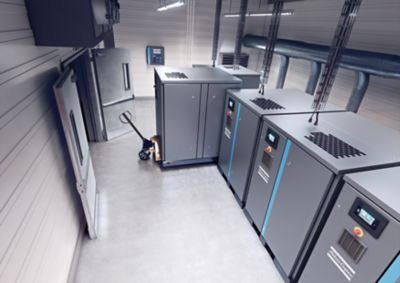Manufacturing’s green revolution is underway as companies take bold strides to reduce their environmental impact. While transformative changes to operations, processes and supply chains are commonplace, compressed air remains largely ignored. This oversight carries a hefty price tag for manufacturers and the planet.
Compressed air is integral to numerous manufacturing operations, from powering pneumatic tools and conveyor systems to applying paint finishes and blasting dirt from machinery. Compressed air is so vital that many refer to it as the fourth utility after electricity, water and natural gas.
This ubiquity comes at a cost. Contrary to perceptions, compressed air is not a free resource. Indeed, compressors can require a tremendous amount of energy. They account for a staggering 10% of industrial electricity use with UK companies spending a combined £1.5bn on compressed air annually.
Worryingly, it’s estimated that as much as 20% to 30% of compressed air is lost through leaks. This has a significant impact on operating costs. A single 3mm hole creates a leak that can add hundreds of pounds a year to electricity bills.
Yet, despite their significant energy consumption and environmental impact, compressed air systems frequently don’t receive the attention they deserve. The most common reasons why include:
- Compressors being hidden away in utility rooms or outbuildings leads to an out of sight, out of mind mentality.
- Production processes and equipment are being prioritised over support systems like compressed air.
- Assumptions that because compressed air systems have been historically stable and affordable due to cheap electricity prices, they are inherently efficient.
- A lack of specialised knowledge and equipment required to identify and repair leaks or optimise components.
Soaring energy prices have served as a wake-up call, prompting many directors to reevaluate their organisation’s energy consumption and energy-saving strategies.
Historically, businesses were paying 10p to 15p per kilowatt-hour. Lately, we’ve seen prices as high as £1.20 per kWh – a 1,100% increase! As a result, energy efficiency has jumped to the top of boardroom agendas. A return on investment that once may have been measured in years can now be delivered in months. This, coupled with more and more companies setting ambitious, science-based emissions reduction targets, means we are seeing greater interest in getting air compressor systems future-fit for businesses and the planet.
A changing landscape has reordered priorities
Industrial decision-makers frequently don’t know the total cost of compressed air in their plant or if their system has leaks. They also don’t know whether they’re producing too much or too little air or whether the pressure level is correct. That’s where Atlas Copco Compressors comes in.
A consequence of being neglected is that compressed air systems won’t keep up with the changing needs of a business. It’s unlikely that compressors will be optimised and benefit from energy-efficient developments like variable speed drive (VSD) technology or compressed air heat recovery. Electricity makes up 70% of a compressor’s total cost of ownership. Increasing the energy efficiency of a system delivers environmental benefits by reducing a company’s carbon footprint, as well as financial savings
Variable speed drives make equipment run more efficiently by automatically adjusting the operating speed to match demand in real time. While VSD compressors have been available for some time, Atlas Copco Compressors is looking to introduce its patented VSD technology to secondary equipment like fans, chillers, dryers and filtration systems to deliver additional performance improvements and savings.
Two of Atlas Copco’s customers were each paying 45p per kWh. By upgrading their air compressor equipment, they saved £80,000 and £35,000 a year, respectively. In addition, both achieved double-digit carbon savings and saw a reduction in annual maintenance costs.
Free audit means no excuse not to act
To help companies, Atlas Copco offers three levels of health checks and energy audits for compressed air installations that assess whether there are opportunities for performance or efficiency improvements.
Level 1 is a free visual inspection and energy potential calculation (EPC).
A visual assessment covers information such as the compressor room environment, any air quality issues and a visual inspection of all compressed air equipment on-site, including appropriate capacity, ISO compliance, unproductive running, and pressure levels. A written summary of the equipment health is provided, outlining running equipment improvements, wasteful practices or non-conformance with ISO standards, along with an estimate of potential cost and energy savings.
Level 2 is a free energy assessment and recommendations through data logging (AIRchitect).
Where the EPC shows potential energy savings, the AIRchitect sees logging equipment fitted to each compressor that records and maps energy consumption over seven days. This data is used to calculate a realistic energy savings potential, make simulations and provide recommendations to achieve optimal energy efficiency. A one-week compressed air flow audit of a cement producer revealed potential savings of £23,500 (11% of annual energy costs) through upgrading to VSD+ compressors and a CO2 emissions reduction of 140 tonnes a year.
Level 3 is a full AIRscan audit to ISO 11011 standard.
This premium service assesses a range of parameters, including flow testing, air leak detection, air quality testing, measurement and analysis of pressure and dew point throughout a whole system, from compressor room to production processes.
This assessment helps identify the most suitable methods to reduce energy costs and CO2 emissions. While AirScan reporting isn’t free, this audit almost always pays for itself in savings.
If you haven’t had your air compressor system audited in the past 12 or 18 months, I’d urge you to look at undertaking one. It won’t cost you anything. The worst-case scenario is that one of our experienced engineers says your system is working perfectly.
The best-case scenario is you are given a practical, quantifiable roadmap to reduce your electricity consumption, energy bills and carbon footprint. It really is a win-win-win.





